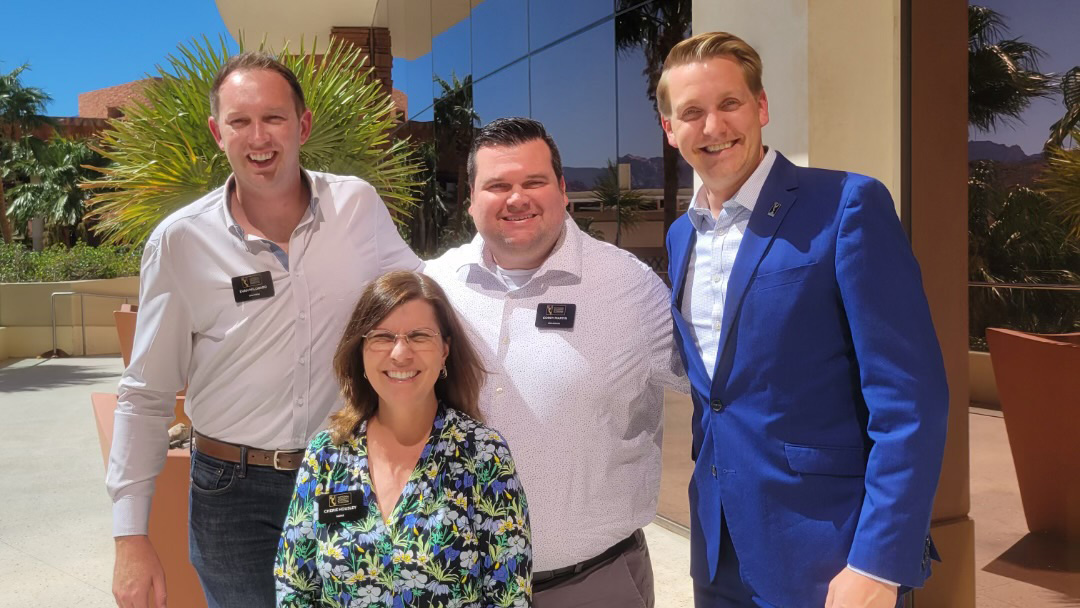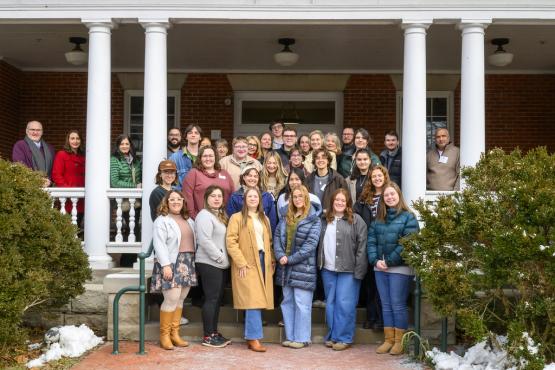
Did you know the Emmy Awards isn’t just about recognizing entertainment? Long considered the gold standard for television excellence, this prestigious award also honors achievements in news and journalism, where industry shifts are raising new questions about how excellence is defined.
Once hemmed in by scheduled programming on traditional networks, the news industry has transformed into an on-demand medium driven by streaming services, digital platforms and shifting viewer habits. News organizations have adapted by expanding their digital presence, producing content tailored for social media and integrating multimedia storytelling. As a result, the lines between television, online video and digital journalism continue to blur.
The National Academy of Television Arts & Sciences (NATAS), which oversees the News & Documentary and Regional Emmy Awards, is continually evaluating whether its criteria should evolve to reflect these changes. Regional chapters of NATAS, such as those led by OHIO’s Scripps College of Communication alumni Corey Martin, BSJ '00, president of the Mid-Atlantic chapter; Evan Millward, BSJ '11, president of the Ohio Valley chapter; and Brooks Jarosz, BSJ '09, president of the San Francisco/Northern California chapter, are leading these discussions to ensure the Emmy Awards remain relevant in today’s news media landscape.
Diversity in regional Emmy chapters
NATAS chapters address diversity in ways that reflect the unique needs of their regions while striving for broader representation in the television industry. Each chapter's approach is tailored to its demographic, but all share a commitment to equity and inclusion.
For Millward and the Ohio Valley chapter, geographic diversity is a key priority, ensuring that the chapter represents the broad area it serves.
“Our board has to represent parts of four states,” Millward said. “Geographic diversity for my board is always in the back of my mind. We cover the Columbus, Dayton and Cincinnati markets in Ohio, as well as all of West Virginia, parts of Kentucky and parts of Indiana. It's a priority for us to represent every area we serve.”
Millward also emphasizes that diversity should go beyond geography to include a variety of backgrounds.
“If all of your reporters live in the same part of town, that is not great,” he said. “Diversity should include everyone, and it makes the work we do much better and more representative.”
Martin, from the Mid-Atlantic chapter, shares a similar commitment to diversity but focuses on the range of professional backgrounds represented in his chapter.
“We have people from every region in our chapter,” Martin says. “It’s not just traditional newsrooms anymore. We’ve got college professors, high school teachers, people from Telemundo and Univision stations. It’s important to us that these diverse groups are represented.”
On the opposite coast, Jarosz, a five-time Emmy recipient, and the San Francisco/Northern California chapter also place a significant emphasis on recognizing Spanish-language journalism.
“Because we have several Spanish-speaking stations, we want to make sure that we are offering stations that cater to specific audiences, to have a place to enter, to be awarded excellence and get the Emmy,” said Jarosz.
Additionally, the chapter has launched scholarships, such as one for Native Hawaiian journalists, helping underrepresented groups find their voice in the industry.
“Hawaii is part of our chapter. The scholarship was created in memory of KITV managing editor Robert Kekaula, specifically for Native Hawaiians to fund their educational studies,” said Jarosz. “We are helping those who may otherwise not always have a seat at the table in some of these newsrooms.”
Jarosz continued.
“So there’s many aspects that NATAS tries to make sure that we’re sensitive to all of those people that are part of our organization and to make sure that those voices are being represented, both from the youngest students to those who are proudly serving our community as journalists.”

With 19 chapters nationwide, NATAS counts three Scripps alumni among its presidential leadership. From left to right: Evan Millward, president of the Ohio Valley chapter; Cherie Stofey Housley, Head of Academy Operations, NATAS; Corey Martin, president of the Mid-Atlantic chapter; and Brooks Jarosz, president of the San Francisco/Northern California chapter
Addressing AI in content and awards
Artificial intelligence has become a hot topic in television production and awards eligibility. Preserving the integrity of Emmy Awards submissions, especially as AI-generated content becomes more advanced, is of vital importance.
“If we don't have the integrity of the contest and if we don't have the integrity of the organization, then we have nothing,” Millward said. “We are awarding a standard of excellence, and if you are submitting something that you didn’t create, that’s going to be a problem. We just have to figure out how to use it to the best of our ability when it comes to content creation.”
Martin shared his concern about AI’s potential for plagiarism, which is always a consideration for television excellence recognition.
"I'm still very leery of AI,” Martin said. “I'm an old-school journalist who still is terrified of the implication of plagiarism, and so, I wouldn't want anyone passing off something as their own original work when it was generated by AI."
While AI can't replace the human element of storytelling, Martin recognizes that it may hold some value in the future.
“I think AI can have its place as it continues to evolve and can be fine-tuned or properly vetted somehow, as it relates to reporting,” he said.
Local news in a shifting media environment
Before smartphones and streaming services, many people relied on the evening news for weather updates and local headlines. Martin, who has witnessed the shift firsthand, explained.
“I’m going to be 47 this year, and people my age are probably the last generation to really sit down and watch the evening news at six,” he said.
This shift is reflected in the declining viewership of traditional newscasts.
“The research in every market identifies a heavy local TV news viewer today as two to four times a week,” said Millward. “No one is watching every newscast, every day.”
As viewership habits change, the distinctions between traditional and emerging media are fading. Streaming documentaries, digital media journalism and independent productions are now competing alongside legacy broadcasters, challenging long-established definitions of quality. These shifts are prompting organizations like NATAS to rethink how excellence is recognized across a variety of formats.
The future of streaming and digital content in the Emmys
A major challenge for NATAS is how to incorporate the growing prominence of streaming content and digital-first productions into the Emmys.
“We're having discussions all the time about what content is allowed versus what is not,” Jarosz said. “A central concern is balancing the recognition of streaming content with traditional broadcasts. To stay relevant, we’re going to have to increasingly embrace streaming platforms.”
The rise of short-form content, such as TikTok videos and Instagram reels, has also prompted the introduction of new Emmy categories.
“We used to only differentiate between news and non-news, but now we also have short-form and long-form,” Martin said.
This shift acknowledges the audience demand for shorter, more accessible content.
“If you can give me something in, say, 10 minutes, I can watch that on the bus or on my lunch break,” Martin said.
Some chapters are experimenting with categories specifically for short-form content, reflecting the influence of platforms like TikTok.
“A good content creator can reach more people with one reel or TikTok than any local newscast on any given night,” Millward said.
The rise of AR and virtual production
While technology like AI presents challenges, augmented reality (AR) and virtual production are steadily gaining traction as tools for enhancing storytelling. Stations across the country are adopting these technologies to create more engaging broadcasts.
“It’s immersive,” Martin said. “It takes viewers along for the ride in certain ways if it’s done correctly. We just need to be clear with viewers about what they’re seeing.”
The shift toward AR is even more pronounced in the Bay Area, a global hub for technological innovation.
“KPIX CBS Bay Area has gutted its entire set,” Jarosz said. “Everything is virtual; everything is green screen, their whole entire studio. They don’t have a traditional set anymore, and they have this very immersive weather set. They’re now doing much more of that on the news side too, where anywhere they walk, they’re in a different world. It’s all AR- and AI-driven.”
As AR continues to transform the industry, it’s clear that new technology will reshape television production in the years ahead. The Emmys, like the rest of the industry, will need to adapt to recognize these innovations in content creation.
Ensuring fairness: The Regional Emmy judging process
The process of determining who is deserving of an Emmy involves rigorous standards set by NATAS chapters across the country. The regional chapters of the Emmy Awards play a key role in ensuring that judging is fair and reflective of the diverse and evolving landscape of television content.
To maintain fairness, chapters like the Ohio Valley chapter utilize a peer-based judging process, where industry professionals evaluate each other's work across different categories. Judges are selected from a variety of backgrounds to bring a broad perspective to the awards process.
“When we’re judging, we rely on a peer-to-peer system,” Millward said. “We’ve got news directors, reporters, producers and even people who work behind the scenes. It’s really about making sure we give everyone a fair shot. The goal is to recognize the best content, regardless of where it comes from.”
The process involves multiple rounds of judging, with entries being scrutinized by experts in the field. This helps ensure that only the most outstanding work is recognized.
“We want to make sure that the people who win our awards are the best,” Martin said. “And to do that, we need to have a transparent, accountable system in place.”
The inclusion of diverse perspectives in the judging process also ensures that various styles of content, from local news to digital-first productions, are fairly represented.
“In some cases, you’ll have people who might not be familiar with the type of content being judged, but we’ve worked hard to make sure they understand the standards,” said Martin.
Jarosz noted the challenges of judging content from diverse regions and platforms but emphasized the importance of giving all work an equal opportunity for recognition.
“You’ve got to look at everything on its own merits,” he said. “The world is evolving, and so is television. The judging process needs to reflect that.”
From Ohio University to NATAS leaders
Having a passion for television led Martin, Millward and Jarosz to Ohio University, where they honed their skills and built lasting connections. Their paths reflect how their shared Bobcat roots continue to influence their leadership in the television industry.
“It's pretty special having two other Bobcats that I know personally also representing chapters within the National Academy of Television Arts and Sciences as presidents, because we get to get together once a year and recall all these old times at Ohio University,” said Jarosz.



